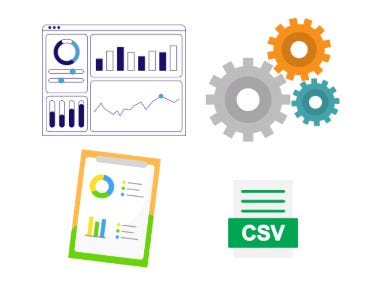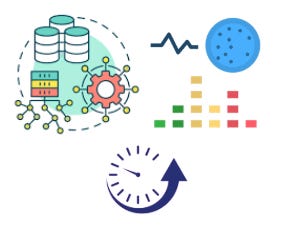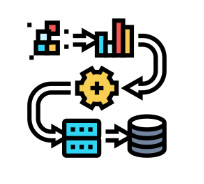Pipeline Design and Implementation for Small-Scale Data Pipelines
A guide to planning, designing, and building small-scale data pipelines
Not every data pipeline must support millions of rows per second or handle dozens of microservices. Most data engineers regularly build and maintain small-scale pipelines focused on a specific team, project, or use case. Whether syncing data from a Google Sheet to a database, cleaning up CSV exports, or ingesting data from a public API, these pipelines are simple by design but critical in value.
Small-scale pipelines are often:
Built quickly to solve a real business problem.
Owned by a single engineer or a small team.
Used internally for reporting, experimentation, or operational needs.
They appear early in a company’s data journey, during MVPs or one-off analytics requests, and continue to exist even in mature data teams. Despite their smaller scale, these pipelines deserve careful attention since a poorly designed one can become a long-term pain point, while a clean and modular one can serve as a reliable building block.
In this post, we’ll walk through how to plan, design, and implement small-scale data pipelines and how we are doing in practice.
Understanding the Problem Scope
Small-scale doesn’t mean low stakes!
Before writing a single line of code, the most important step in pipeline design is to fully understand the problem we are solving. A clear plan in the beginning can save hours of rework later.
What is the Data Source?
We should first identify where our data is coming from:
Is it a CSV export, a third-party API, a database, or a Google Sheet?
Will it be pulled (we fetch it) or pushed (we receive it)?
How often is the data updated? Daily? Real-time?
Knowing this will shape our decisions around scheduling, retries, and performance.
What is the Goal?
What’s the end use of this pipeline?
Feeding a dashboard?
Populating a report?
Training a model?
Preparing a flat file for finance or ops?
Always keep the consumer in mind. The more specific we are about the expected outcome, the better we can shape your pipeline logic. In the end, our pipeline is as valuable as it helps our stakeholders.
Who Are the Stakeholders?
We should know your audience and collaborators:
Are you the only one maintaining this?
Will someone else consume or review the output?
Is this part of a larger project or a temporary solution?
Even simple pipelines benefit from being documented and reproducible, especially if you step away or need to hand it off later.
What is the Data Size and Frequency?
Even for small-scale pipelines, understanding volume and frequency is important:
Are we talking hundreds, thousands, or millions of records?
Will it run hourly, daily, or on demand?
Can it fit in memory for transformations (e.g., with Pandas), or does it require chunking?
This will influence our tool choices and performance planning.
What Are the Constraints?
Any rate limits, API auth, or file format quirks?
Do we have limited compute, memory, or access?
Are there security or compliance considerations, like PII?
A clear grasp of technical and organisational constraints ensures our pipeline works reliably and safely within its environment.
Design Principles
Just because a pipeline is small doesn’t mean it can be messy.
Small-scale pipelines benefit the most from clean, thoughtful design because they’re often built fast and reused longer than expected. Here are the key principles to keep your pipelines maintainable and effective:
1. Keep It Simple: Choose the simplest possible tool that solves the problem. Simplicity helps us build faster, debug quicker, and onboard others more easily.
2. Modularise the Pipeline: Split the process into clear stages such as Extract, Transform, and Load. Keeping these stages separate improves readability and makes it easier to test and replace parts when things change.
3. Make it Reproducible: Our pipeline should produce the same result every time, given the same inputs.
4. Log Properly: Add basic logging to track what’s happening. Even a few log lines in stdout or a log file to track the start and end time of each step, number of records processed, warnings, and edge cases can save a lot.
5. Consider Failures: Things will break. Even simple retry logic or writing errors to a separate file can prevent data loss and headaches.
6. Build for “Small but Growing”: Start small, but think a step ahead. A bit of foresight means your pipeline won’t need to be rebuilt from scratch when the scope expands slightly.
Choosing the Right Tools
We are not just solving a problem, we are solving it in a way that fits the system.
When designing a pipeline, our choice of tools should be guided not just by what’s fastest to implement but also by what fits naturally into your team or company’s existing ecosystem.
This isn’t just about convenience, it’s about long-term sustainability. A pipeline that blends well with existing workflows is:
Easier to hand off or scale
Faster to troubleshoot
More likely to be reused or extended
Align with What Already Works
Before picking something new, we should ask:
What tools does the team already use for data storage, scripting, or orchestration?
Are there internal conventions, frameworks, or even naming standards to align with?
Will someone else maintain or extend this in the future?
Are we introducing something that might create tech debt?
Choosing familiar, supported tools means:
Onboarding new teammates is easier
Less duplication of functionality
Avoid siloed systems or "one-person" pipelines
Match the Tool to the Task (Not the Other Way Around)
Small-scale pipelines don't need complex solutions. But simple doesn’t mean sloppy. It means choosing the right level of abstraction for the task:
If the data fits in memory and only needs occasional processing, don’t reach for distributed tools.
If the team uses SQL heavily, lean on SQL-based transformations rather than something else like Python.
If there’s already an internal scheduler or workflow manager, integrate with it instead of spinning up something new.
This mindset helps us stay efficient and aligned with our environment.
Prioritise Maintainability
These are always good to keep in mind as we select tools for our pipeline:
Minimise tool count: each additional tool adds complexity.
Prefer community-supported and documented tools: these save time in the long run.
Avoid tightly coupling the pipeline to niche tools or services unless we are solving a very specific problem.
Don’t optimise for scale we don’t need: optimise for clarity, portability, and ownership.
Implementation Approach from a Data Engineer
Rather than list steps in abstract, let’s walk through how I think and act when building a small-scale pipeline. The tools and tasks may change, but the mindset remains consistent.
Step 1:
What decision or action will this pipeline support?
I always begin by clarifying the why. If a stakeholder wants a cleaned dataset or a weekly report, I want to know:
Who’s using it?
How often?
What will they do with it?
Understanding this helps me frame the pipeline backward: from output → data model → transformations → source.
Step 2:
Before touching code, I sketch it on paper.
I write out:
Data source (e.g., an API or database)
Transformation needs (e.g., filter spam, parse rating fields, join metadata)
Destination (e.g., internal Postgres DB or Data Warehouse)
Even in small projects, a simple outline helps me. If I can’t explain the flow clearly, the pipeline isn’t ready to build yet.
Step 3:
Assumptions break pipelines. I inspect the data first hand. (if possible)
I pull sample records, look at edge cases, and check things like:
Are dates consistent?
Are any fields unexpectedly nested or missing?
Do I need to deduplicate or reformat?
This is where experience pays off. Learning to expect messy data helps me design better transformations.
Step 4:
Even in quick scripts, I separate extract, transform, and load.
My extract step might be a Python function calling an API with pagination.
The transform step is where I keep things clean: using Pandas or SQL, with logging for record counts and nulls.
The load step might be
to_sql()or a file export. However, always isolated so I can rerun transformations without re-downloading the source.
If something fails, I want to know which part failed and why, but I do not want to dig through a 300-line script for each error.
Step 5:
I plan about logging, testing, or failure handling from the beginning.
Even in a small pipeline, I add:
Basic logging (start time, rows processed, error messages)
Schema checks (column presence, expected types)
Retry logic for flaky APIs
This takes minutes but saves hours, especially when someone asks, “Hey, why do the numbers look off?”
Step 6:
If it needs to run more than once, I make it repeatable from day one.
I wrap the pipeline in a CLI or parameterised script. I avoid hardcoding file paths or dates. I might add a simple --dry-run flag or --start-date input.
It doesn’t have to be a robust framework, but it needs to be runnable without edits.
Step 7:
The pipeline isn’t done when the data is loaded, it’s done when someone else can run it.
In the end, I:
Remove unused code
Add a short README or comment block explaining inputs and outputs
Leave clear TODOs or assumptions
Documentation isn’t a formality, it’s the bridge between us and the Future us (or someone else on our team).
When to Refactor or Scale Up
Not every pipeline is meant to last, but some of them do.
A quick script built for a one-off report quietly becomes part of your weekly ops. A simple scheduled job starts breaking because the data has doubled. Sound familiar?
As data engineers, one of our key responsibilities is to recognise when a small pipeline is outgrowing its shape and take action before it breaks in production.
How Can We Know It’s Time to Refactor?
Here are the signals we can watch for:
Pipeline Logic Is Hard to Follow: We have to scroll up and down constantly just to trace one transformation. If our extract-transform-load stages are blurred together, or the logic is tightly coupled and hard to test separately.
We are Copy-Pasting or Rewriting Code Often: This is a strong sign that a shared utility module, configuration file, or even a lightweight library would make the pipeline more maintainable.
The Pipeline Fails More Frequently: Add resilience: retries, fallbacks, error logging, and validation. Maybe it’s time to switch from ad hoc scripts to a scheduler that supports retries and alerts.
Data Volumes Have Grown: Increased volume can introduce:
Memory issues
Timeout problems
Longer runtimes that outgrow our local machine or scheduler
Consider chunking, batching, or moving parts of the pipeline to a database or scalable tool.
More Stakeholders Now Rely on the Output: We may need better documentation, more consistent delivery, better monitoring, and ownership.
If you're spending more time maintaining the pipeline than benefiting from it,
It’s time to refactor or scale.
Conclusion
Small-scale pipelines may be simple in scope, but they are foundational in practice. When built with intention and guided by clean design, they become reliable building blocks for decision-making, experimentation, and operational efficiency.
If you find this post helpful, you may also enjoy these posts about Data Engineering:
















Great article! Thanks for sharing